by
Rhythm Scene Staff
| Feb 01, 2019
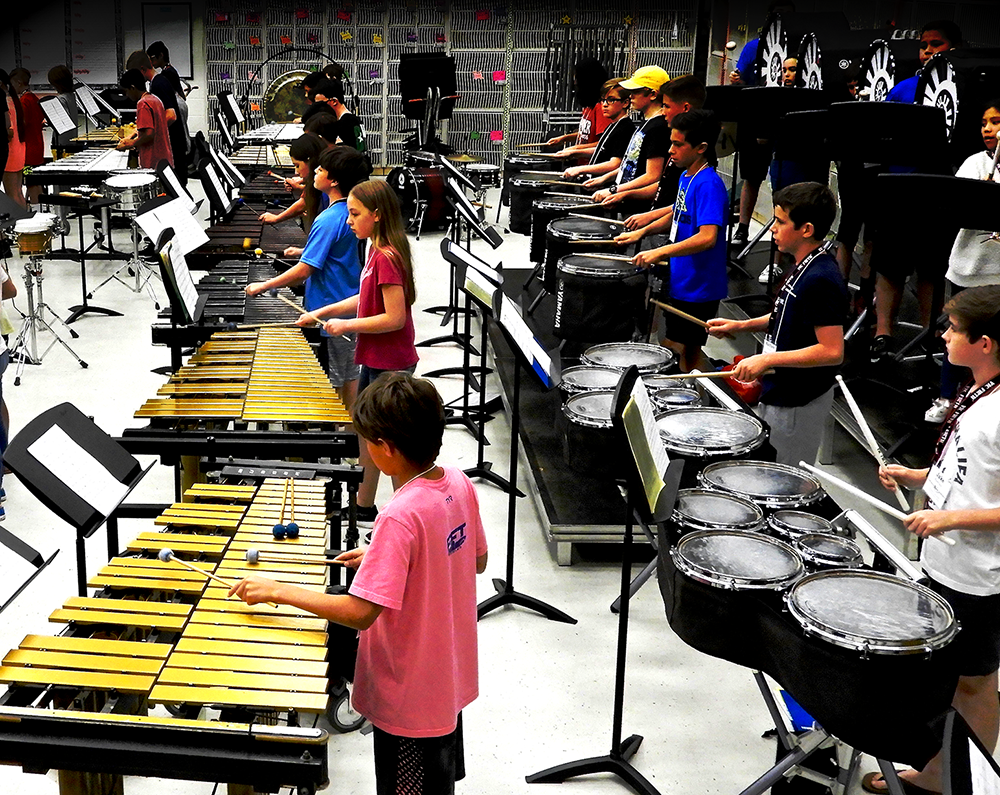
Although it may be the middle of winter, who hasn’t thought about summer plans? A vacation at the beach? An afternoon at the ballpark? How about a percussion camp? Particularly for younger percussionists just starting out, no longer a “beginner” but not quite ready for more advanced musical opportunities, summer camps and workshops can be the perfect musical stepping stone.
For first- and second-year percussionists in Texas, there is an excellent opportunity in the North Texas Middle School Percussion Camp, founded and run by Kennan Wylie. Held each June at Marcus High School in Flower Mound, Texas, students entering the 7th or 8th grade can benefit from the total percussion experience geared specifically to their burgeoning skill levels.
Wylie is the Director of Percussion at Marcus, a position he has held since 1990. During his 29 years at the school, the MHS percussion ensemble has performed at PASIC four times: winning the International Percussion Ensemble Competition in 1999, 2003, and 2011, and playing a Terrace Concert at PASIC 2000. Their drumline has appeared at PASIC twelve times, winning the High School Marching Division ten times as well as the Standstill Division title in 2009 and the Small Ensemble Title in 2006. Wylie and his percussionists have given clinic/performances four times at the Texas Music Educators Association (TMEA) convention (in 1998, 2002, 2004, and 2008) and have also been featured at the Midwest Band and Orchestra Clinic in 2006 and again this past December. The Marcus High School Marching Band has won the State Marching Championship in its category five times (in 2006, 2008, 2010, 2012, and 2014), and the Marcus Wind Symphony was named TMEA Honor Band in 2015.
So why is the percussion program in this suburban school, located 30 miles northwest of Dallas, so successful? Much of the credit goes to Wylie, who holds bachelor’s and master’s degrees from the University of North Texas, and to his emphasis on beginning percussion education. His book Simple Steps to Successful Beginning Percussion (with volumes on snare drum and mallets) is popular with schools across the country.
“Most of the camps in our area are for high school percussionists,” Wylie explains. “There were no summer activities for kids going in to 7th or 8th grade, unless they were taking private lessons. In the early 2000s, I taught at the SFA Percussion Symposium (held at Stephen F. Austin State University in Nacogdoches, Texas) and they had a middle-school track, which I really liked. When that camp disbanded, I decided to start my own middle-school camp here in the Metroplex.”
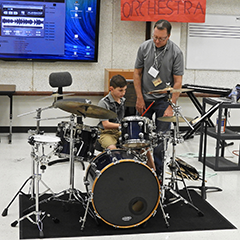
Kennan Wylie coaches 7th-grader Sam Schulz on the drumset.
Founded in 2004, the first North Texas Middle School Percussion Camp hosted about forty students. In recent years, attendance has grown to almost 100 young percussionists from across the state. “They aren’t just my students,” says Wylie. “These kids are from different schools in all parts of the Metroplex. One year we had a gentleman from Waxahachie rent a van and drive eight students up here every day; that’s about an hour each way! We’ve had kids from Houston, Austin, and San Antonio—especially those with grandparents in the area, so they have someplace to stay. We even had a student from Virginia last year. I think the other band directors, and parents, see the value in this camp and want to see their kids exposed to more percussion in the summer.”
“I was thrilled with the variety of percussion that was taught at the camp,” says Laurel Bates, whose son Tosh attended for the first time. “What a valuable experience for my son! His confidence in all aspects of life have increased as he learns and grows in percussion.”
THREE DAYS IN JUNE
The camp meets for three days (Tuesday through Thursday), from nine in the morning until four in the afternoon, with an hour break for lunch. “We found that kids this age get tapped out after three intense days of learning,” Wylie explains. “High school kids can usually go five days, but middle school students lose focus after the third day. We push them to their limit as far as how much we can expose them to before they begin to shut down.
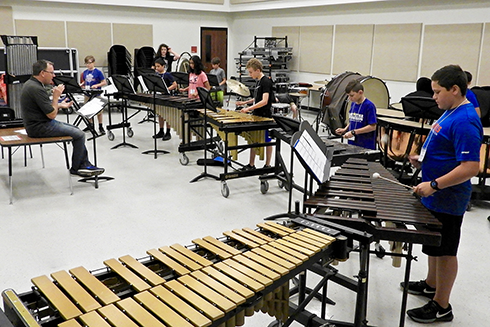
Kennan Wylie rehearses one of the blue ensembles.
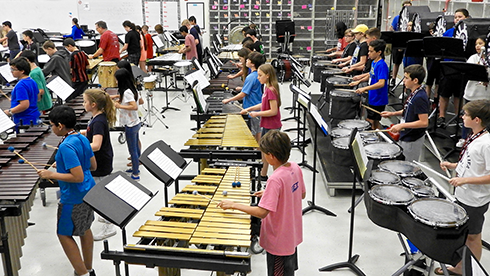
Students begin to put together the mass ensemble the day before the concert.
“It’s a full curriculum-based camp,” he continues, “which means we try to cover all the percussion instruments that these kids should be exposed to before they get to 9th grade. We do master classes on snare drum, keyboards, timpani, Latin percussion, drumset, and even a track on marching percussion. Each student gets a one-hour master class in all six areas. In addition to that, they also receive an hour of percussion ensemble every day, plus an hour of practice time.”
When the students arrive on the first morning, they audition for staff members, playing a short excerpt or two of their choice—maybe a band audition etude or solo. They are also required to sight read on keyboards and snare drum. Following these auditions, the staff divides the students into eight groups, based on similar abilities, which makes rehearsing a new ensemble—and performing it less than three days later—an achievable reality.
“We try to maintain eight working ensembles of 10–12 students each,” Wylie says. “We divide them into four basic sections, designated red, yellow, green, and blue, each with an A and B subsection. Obviously, if some kids are freshly out of their first year of beginner percussion and are still working on their reading skills, we’ll put them in a different group than those who are a little bit more down the road of reading and playing. We try to steer away from stereotyping—no first chair, second chair, top group, or bottom group. We just use the colors, which makes for a more ‘camp-friendly’ atmosphere.”
With sessions running simultaneously in four separate rooms, students attend two hour-long master classes each day. During the snare drum class, they are shown the parts and care of a snare drum. They are also exposed to rudiments and exercises. Keyboard fundamentals include major and minor scales and an introduction to ragtime xylophone and four-mallet marimba. Some students even play on a vibraphone or marimba for the first time, in addition to the more standard bells and xylophone.
The second day brings the world to them as the students get hands-on time with bongos, congas, claves, agogo bells, and a host of Brazilian instruments, including surdos, pandeiros, tamborims, shakers, woodblocks, and cowbells. Many of the students also get their first opportunity to play on marching drums during the drumline masterclass, playing a couple of exercises on snare drum, multi-tenors, or bass drum before rotating to the next instrument.
“My favorite thing about the camp,” remembers Sam Schulz, a 7th grader at Seneca Ridge Middle School in Sterling, Virginia, “was playing the marching drums. I would go back again because it was fun playing a variety of percussion instruments.”
On the third day, in addition to more ensemble rehearsals and a dress rehearsal for the final concert, the students are exposed to timpani. Ranges, intervals, tuning, and mallets can be an eye-opening experience for someone used to playing on a bell kit or practice pad. And perhaps the most anticipated master class is on drumset. Utilizing Wylie’s new book, The Complete Drumset Method (published by Hal Leonard), the class also featured drumset artist Gregg Bissonette on the accompanying video, allowing the students to play along with him and actual music.
In addition to each student learning his or her part to a new percussion ensemble, everyone participates in the finale: a mass ensemble performance of “Brazil” (by S.K. Russell and Ary Barroso), arranged by Diane Downs and Rick Mattingly (part of the Leopard Percussion series). Seeing the joy on the faces of young percussionists playing this infectious music brought smiles to everyone in the audience. “We use everything from steel drums to Brazilian instruments in the finale,” Wylie says with a grin. “We even put the drumline into it, which is a sight to see. It’s very cool to see all the kids playing together.”
“I liked when we got to show our parents what we learned during the camp in our concert,” explains Ryan Andrews, a 7th grader at Central Junior High School in Bedford, Texas. “I really enjoyed learning about world percussion instruments, especially the Brazilian bass drums. I would like to go again to discover more new things about percussion and build on the things I learned last year.”
“It’s just fun to play in a group with 80 other people, especially if you’ve only played in a small ensemble before,” adds Mark Biggs, who has taught at the camp since its inception. “It’s the camaraderie of performing and reacting with the other percussionists.”
THE STAFF
Kennan Wylie does not teach all these students by himself. He is joined by three other percussionists who have been with this camp for many years. Mark Biggs also received his bachelor’s and master’s degrees in music ed from the University of North Texas. He was a former band director at Marcus, as well as at Lamar Middle School, and is currently a math teacher at Harwood Junior High School in Bedford, Texas.
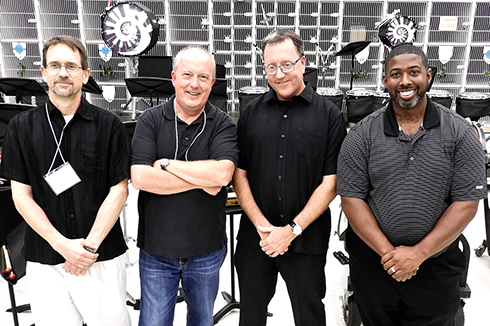
Faculty at the North Texas Middle School Percussion Camp includes (L-R) Mark Biggs, Jon Lee, Kennan Wylie, and John Bingaman.
“This camp gives young percussion students the opportunity to see and try a lot of new things,” states Biggs. “We don’t have time to get very deep into anything, but I think it’s an eye-opener for kids who have only had a year of beginning percussion. Even if they’re in a school with a really strong percussion program, they get to hear different instructors, see instruments they’ve never seen before, and play music they’ve never played before. That’s really important. As percussionists, we value diversity and the ability to play different styles and different instruments from different cultures so much, that a camp like this is really important to expand the horizons for kids who only have a year under their belt.
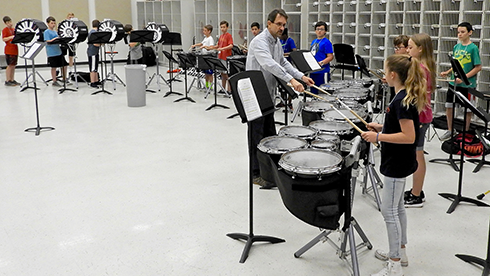
Mark Biggs explains a drumline exercise during the marching class.
Another longtime staff member is Jon D. Lee, who has been teaching at this camp for over a decade. Lee, who received his bachelor of music degree from UNT and his master’s in percussion performance from Southern Methodist University, where he is currently an Adjunct Professor of Percussion and director of the Meadows Percussion Ensemble, is also a freelance percussionist in North Texas.
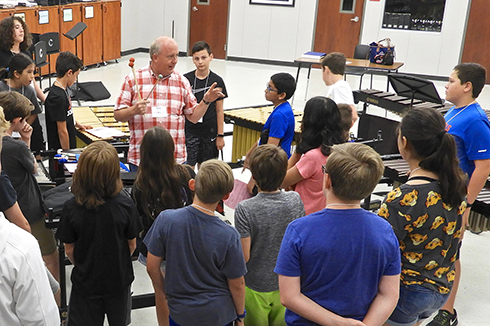
Jon Lee explains mallet choices during the keyboard class.
“No matter how good, smart, capable, competent, and successful any percussion teacher is,” explains Lee, “we all want to send our students someplace so that they get as much information and as many experiences as possible. They may hear the same information you have given them, but if they hear it reinforced by somebody else, then it makes you look smarter! And our students benefit, whether they come from successful programs or are home schooled. This is just a cool opportunity.
“Our staff is so comfortable with each other that we just know what to do,” he adds. “And the end result is something special. We put together a nine-piece performance in two days, in addition to having hands-on clinics on every aspect of percussion. We have all the equipment that we need, plus great student helpers, and the focus is always on the kids. It’s all concentrated into three days, and everyone gives us their best effort for each of those days.”
The most recent addition to the staff is John Bingaman, who joined Wylie, Biggs, and Lee a couple of years ago. Bingaman, a graduate of the University of Louisiana-Monroe, is in his 18th year of teaching music, currently the Associate Band Director and percussion instructor at Byron Nelson High School in Trophy Club, Texas. “This camp is important because it keeps the instructional momentum going,” he explains. “It’s so easy for students to go home over the summer, especially after they finish their beginner year, and not really know what to do. This camp exposes them to a lot of things that they’ve been interested in but don’t get to cover, and it gives them a chance to play with other students. The more times that they get a chance to play in an ensemble, the better. Plus, they learn about individual percussion instruments that, frankly, we don’t have the time to cover as thoroughly during the school year as we would like.
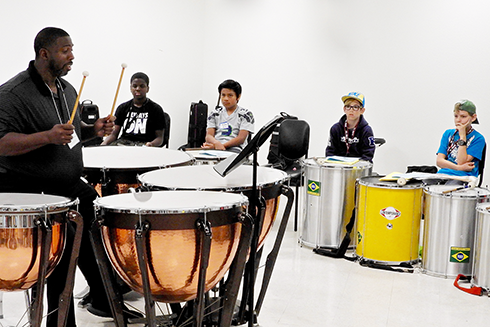
John Bingaman demonstrates timpani technique to the students.
“I try to teach ensemble skills—being able to count and play and then being accountable for your own rhythms and your own music,” Bingaman continues. “I find that sometimes students learn by rote or they’re just trying to memorize it, but when you have a three-day camp, they have to figure out how to count! The students have to practice harder, and it gives them more independence.”
In addition to the four regular staff members, each year Wylie brings in a different guest artist to teach a master class to the entire camp during one session. In years past, they have hosted such percussionists as Christopher Deane and She-e Wu. This past summer, Bill Bachman gave a clinic on multi-tenor drums, incorporating some techniques the students already knew along with new things they would learn in the next few years.
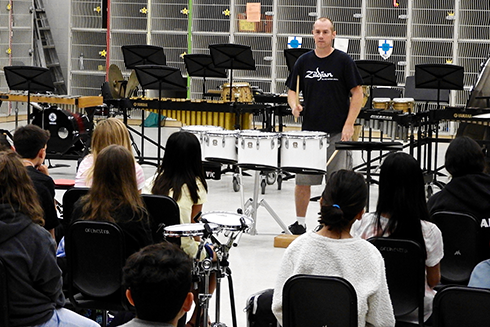
Bill Bachman explained techniques used on multi-tenors during the full camp masterclass.
THESE ARE A FEW OF MY FAVORITE THINGS
“My favorite part of the camp is when all we’re all together, either for the guest clinician or the mass ensemble rehearsal,” Wylie says. “When you see that many young percussionists together in one room, that’s pretty powerful.”
“I usually work with the kids that are closest to the beginner level,” adds Biggs. “I like that moment when we do something and their eyes get really big because it’s brand new for them. Even though we only have a couple of days to rehearse our ensemble, three kids have already come up to me and said, ‘We got a lot better since yesterday!’ The kids knew they got a lot better, which is super exciting! There’s nothing better than that.”
“My favorite part of the camp is the individual classes,” states Bingaman. “I like to get in there and really teach about timpani or Latin percussion or drumset. There are a couple of times when the kids really say, ‘Oh, I didn’t realize that!’ When they thought they knew something but they didn’t quite understand all the way.
“It’s watching the students progress through the four stages of learning,” he continues. “I believe the bottom level is unconsciously incompetent, when students are making mistakes but don’t know it. That’s the place you have to get students away from because they can’t improve, no matter what you do at that level. The next level is consciously incompetent, meaning that they are now aware that they made a mistake. Then students are consciously competent, meaning that they can do it, but they have to use every fiber of themselves to stay concentrated enough to perform it at an acceptable range. And then, eventually, through repetition and consistency, they can get to unconsciously competent, where they can play something at a high level, producing the sounds that you want, with the desirable rhythmic integrity, without thinking about it as much. It’s like riding a bike.”
“This camp helped me learn a lot of different percussion instruments, including Latin, marching, and last, but not least, the drumset,” states Tosh Bates, a 7th grade student at Central Junior High School in Bedford. “It was a very fun and informative experience. And at the end, we all played an amazing ensemble!”
“The students get a lot of instruction in a lot of different areas,” summarizes Bingaman. “They get to meet people. They get to play marching drums. They get to play Brazilian. They get to play in ensemble. They get to learn about individual percussion. And they get motivated about percussion.”
“I wish there were more camps like this,” Wylie says thoughtfully. “There’s a need for it because I think these kids get a little bit swept under the carpet when they go to a high school camp. There’s none of that here; it’s one-hundred percent middle school.
“I would tell other percussion instructors to try to get something like this off the ground, even if it’s just in your local area,” he continues. “Students get more from a percussive point of view instead of just going to a band camp. Expose your students to Latin percussion or drumset. They need to learn about this stuff. And make it an enjoyable experience for them, too.”
Concert Program From 2018 North Texas Middle School Percussion Camp
(June 21, 2018)
“Tequila” by Chuck Rio; arr. Will Rapp (Hal Leonard)
“A La Escuela” by Lalo Davila (Row-Loff Productions)
conducted by Mark Biggs
“Bayport Sketch” by Jared Spears (C.L. Barnhouse)
“Procession of Sardar” by Ippilitov-Ivanov; arr. Kennan Wylie (K. Wylie Publications)
conducted by John Bingaman
“Return to Bayport” by Jared Spears (Kendor Music)
“La Bahama” by Kennan Wylie (K. Wylie Publications)
conducted by Kennan Wylie
“William Tell Overture” by Rossini; arr. Kennan Wylie (K. Wylie Publications)
“Barber of Seville” by Rossini/arr. Kennan Wylie (K. Wylie Publications)
conducted by Jon Lee
“Brazil” by S.K. Russell and Ary Barroso; arr. Diane Downs and Rick Mattingly
(Hal Leonard)